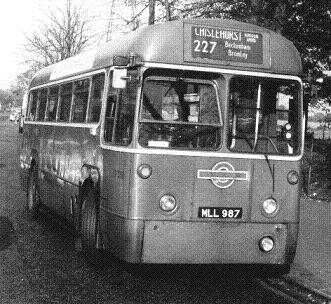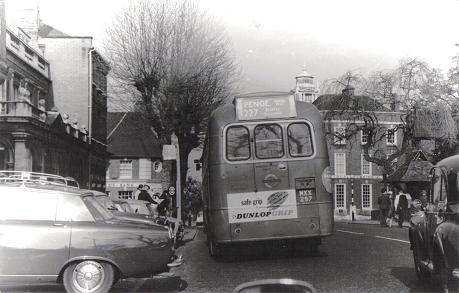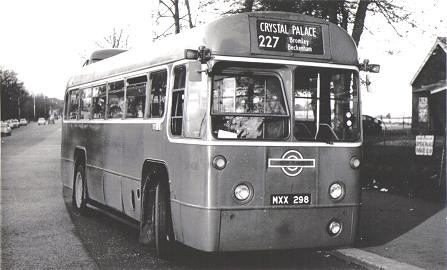Terry Cooper is one of our
readers who contributes as follows:
'I remember the red RFs coming onto the 227 - once I went from
the Palace to Chislehurst in an LT and went past the stop, thus
sadly missing part of a relation's wedding - and used them to
travel to school and later ensured that various girlfriends lived
on it (the last bus back from Chislehurst to Bromley was well after
midnight, a hangover from when ED ran it). And there was
a morning journey that turned (with the correct blind display)
at Chislehurst Station.
When the RFs first came in they must have been heavy on water,
for you would often see one or two on hot days filling up at the
horse trough at Widmore Green before the junction was altered.
Later I worked at 55 Broadway and had the job of arranging
Railway Emergency Services (which they rarely actually were) in the
early 60's and Bromley's RFs were very useful, as they had around
10 spare on Sunday. One special repetitive run was when Penge
Tunnel was shut for several Sundays and Dulwich College wouldn't
allow double deckers through their private roads. We ran RTs fast
from Herne Hill to whichever Penge is on the SECR line, and RFs
calling at all stations, but they had to have mud smeared on the
legal weight, for the RFs (heavier than they should have been) were
above the limit set by Alleyn's. No-one ever knew apart from a
conniving engineer at TB.
We even used an RF from TB at Worcester Park, which was quite a
big job, but on which occasion I don't remember, except that it
took me there from Bromley for the day and brought me back
afterwards.
I left Bromley in around 1964 and moved to Sheffield. '

RF350 is seen on the
famous Crystal Palace Parade stand.
Photo © Adrian Clarke,
Ian Armstrong
collection
Terry adds further memories, this time 'of Friday or
Saturday early summer evenings in the 1960s, whilst (occasionally)
walking on Keston Common. Bromley (TB) was allocated 22 RFs
for a maximum 21-bus run out, giving a four-minute service between
Chislehurst and Penge in rush hours. RFs were very reliable, and
ran to time, and I could actually go out onto Widmore Road for a
specific morning bus and generally caught it.
On Saturdays, however, a 23-bus schedule was operated, probably
with more Palace journeys. So Bromley borrowed a bus every week
from Croydon (off the 234A)
and on Friday you could see it crossing Keston Common running
light, and on Saturday it ran back, following the route that
Metrobus eventually put on to Farnborough Hospital. You could
always tell the Croydon bus by the exterior adverts, and sometimes
the plate above the entrance door was left on. The period I
refer to is roughly 1959 to 1962, and I'm reminded that
occasionally a NX bus spare off the 202 would appear.
Presumably the TC/TB link went back (only 30 years at that time) to
their common ownership by Tillings, even though Elmers End had
previously run the 227. But I think you had to be an
approved driver to be allowed through the Water Tower at
Chislehurst, for it was at an awkward angle for a
30-footer.
Walking back to Widmore Road later in the evening, traffic was
light and the RF has a quite distinctive sound as it approaches,
but the keen ear could distinguish between red ones and the
higher-geared buses on the 725 (for which, of course, there was no
need to rush even though you couldn't see it!). Always
guaranteed to impress the ladies!
I always felt the RF was a very under-valued bus compared to the
RT and later RM. It's the details one remembers, like
noticing around that time that the route numbers on the blinds
reduced in size, and spotting that after going to Aldenham in
around 1961 (second overhaul?) they were coming back with the
chrome around the back-door handle painted over. But they
were very cold in winter!'
Terry's comment about borrowing at the weekend raises an
interesting topic, which we explore further here. Any more information welcome.

November 1968, two years to go, and RF404 crosses
Chislehurst Common.
Ian Smith remembers going to school on the
227 in the sixties:
'Two minutes past eight. I had walked through College Slip in
Bromley from the junction of North Street, West Street and College
Road. There, unless I had walked into Bromley or the
conductor had prevented, I had dropped off the platform of an RT on
the 94 or 126. College Slip took me to the north end of Bromley
High Street, opposite the Swan & Mitre, at the top of Swan
Hill.
I still have a memory from 1952 (when I was four) of a Scooter
LTL passing the end of College Slip.
Well, now it was 8.02, some-year between 1959 and 1966.
As I crossed Bromley High Street I looked south towards the stop
at Bromley Market. If there was a Crystal Palace 227 loading there
I would take up my stand on the corner by the pub (Crystal Palaces
were always full - not worth even trying to get on). If it
was a Penge, I would leg it round the corner and fifty yards to the
bus-stop at the top of winding Swan Hill. Sometimes there
would not be a 227 in sight at all - not a good sign, as they were
supposed to have a "better than four minutes" headway.
I waited at the corner. At the stop opposite
stood a girl about my age waiting for a 227 in the other direction,
towards the Girls Technical High School at Bickley. She arrived by
47. Later I found out who she was, but too late - she was
already going out with my best friend!
 A Penge bus.
A Penge bus.
Penge-bound outside Beckenham
Town Hall.
Photo © MG Webber, Peter Gomm
collection
If a Penge bus didn't arrive within five
minutes it was bad news. That would herald a stream of buses
that wouldn't stop at my request stop, and after four or five I
would be in danger of being late for school. Bunching due to
fog was the worst culprit in most autumn months. By quarter
past eight I would have to run down Swan Hill to Shortlands station
to catch the (more expensive) train to Kent House.
But assuming that a bus arrived, there was the
question of which would it be. It was always a Bromley RF, although
there were occasional strangers. Could these have been the Saturday
borrowings from New Cross held over for some reason? The
Bromley RFs had no doors, but very occasionally a stranger with
doors chained open would be seen while the ban on OPO working
remained in force.
Personal favourite was MXX 2 (RF360), which
seemed to be my regular bus for the first couple of years.
RF367 and RF368 had similar memorable registration plates in those
early days, while RF361 took over in late 1961.
Once on the bus I tried to find a seat for the
wind down Swan Hill into the Ravensbourne Valley. We crossed
the river immediately before the 12 ft 0 in clearance railway
bridge at Shortlands station, where 4-EPBs, a handful of peak-hour
4-SUBs and the occasional steam express rumbled overhead on the
lines to Victoria and Blackfriars (at least in the early
days. Later it was EPBs, HAPs and CEP/BEP
combinations). Very occasionally the Night Ferry was to be
seen, with a West Country spam-can toiling London-wards with a
train of exotic blue Wagon-Lits sleepers, a full train of green
Bulleid coaches, plus a tail of Ferry luggage-brakes and fourgons,
sixteen or so vehicles.
There was a better view of the railway
junction as the bus toiled up the long hill out of the valley on
the west side. Now we were moving away from the artisan
houses of Shortlands to the more affluent suburbia of
Beckenham. Up on the hill we would meet a Green Line RF
heading for Dartford on the 725.
The bus relaxed slightly for the roll down
into Beckenham. Often we would have to stop at the traffic
lights (still a relative rarity in those days), before forking
right for Beckenham Church. Here we met the 126 route
briefly, although I can never remember seeing one there. We
turned left, away from Beckenham Junction, rolled down the hill and
turned right into Beckenham's sinuous High Street. At the end
was another rarity - a roundabout. Not a mini-roundabout but a
proper big drive-round one. We headed for Penge.
The tree-lined road headed for Clock House
Station past Beckenham Baths. Here I would alight if it was
swimming first period. Clock House was where we caught the
train to Eden Park on games afternoons. But that's another
story.

Past the hump of the station bridge we continued along to pass
under the Beckenham Junction to Crystal Palace branch. No
trams in those days, but another possible sighting of a
4-SUB. Nearly there now, we gathered or belongings and
alighted opposite the school, allowing the RF to purr away much
emptier into Penge High Street, probably to turn at the Crooked
Billet.
I don't think that I ever caught the bus on up
the hill to Crystal Palace - except possibly on a Saturday trip
with Dad, when we went up to the Palace from some direction then
caught the 654 trolleybus down towards Croydon. Early
memories of Crystal Palace parade included some awe at seeing buses
doing U-turns in the road, with trolleys turning completely round
the roundabout at the top of Anerley Hill!
Another Crystal Palace shot, this is
RF410. Photo Peter Gomm collection
Going home was just the reverse. There
was a considerable scrum at the request stop outside the
school. Buses from Crystal Palace, loaded with schoolgirls
from up the hill, tended to run straight past. The
headteacher remonstrated with us at Assembly about unruly behaviour
at the stop. But after about three or four buses I could
usually get home for the switchback return to Bromley, where I
would alight at College Slip or Bromley Market Place. The final
climb from Shortlands to Bromley was often a struggle, but I cannot
remember an RF ever breaking down anywhere on the route.
I don't remember catching the 227 eastwards
from Bromley during my schooldays, although I often traversed it on
my bike. But I made sure to do the run during the Sidcup
Running Day! From Bromley the bus would have filled up
with girls for Bromley Girls Tech, and headed out eastwards along
Tweedy Road, past the Council offices and Police Station, out to
Bickley, where it would discharge its schoolgirls before the
twisting dive down into the valley.
The route passed under the Charing Cross line,
then climbed very steeply up the long hill to Chislehurst
Common. There, until it was demolished, all traffic,
including buses, had to squeeze alternately through the tiny arch
in the bottom of the water tower. At Chislehurst War Memorial
the 227 turned left into Chislehurst Village, and ran round the
block to terminate at the Gordon Arms.'